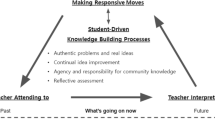Abstract
This research introduces a method to construct a unified representation of teachers and students perspectives based on the actionable knowledge discovery (AKD) and delivery framework. The representation is constructed using two models: one obtained from student evaluations and the other obtained from teachers’ reflections about their teaching practice. We integrate both models into one that incorporates students’ opinions and teachers’ knowledge and meta-knowledge. This method provides a representation of a teacher’s best teaching practices where student perceptions are presented as patterns in the form of association rules. The representation adds actionability to association rules by demonstrating how students’ association rules are related between themselves and how they are related to teacher’s meta-knowledge.












Similar content being viewed by others
Explore related subjects
Discover the latest articles, news and stories from top researchers in related subjects.References
Bailey, C., Baines, P. R., Wilson, H., & Clark, M. (2009). Segmentation and customer insight in contemporary services marketing practice: why grouping customers is no longer enough. Journal of Marketing Management, 25(3–4), 227–252. doi:10.1362/026725709x429737.
Bing, L., Wynne, H., Shu, C., & Yiming, M. (2000). Analyzing the subjective interestingness of association rules. Intelligent Systems and their Applications, IEEE, 15(5), 47–55.
Cao, L., Zhang, C., Yu, P., & Zhao, Y. (2010a). D 3 M Methodology. In Domain Driven Data Mining (pp. 27–47): Springer US.
Cao, L., Zhao, Y., Zhang, H., Luo, D., Zhang, C., & Park, E. (2010b). Flexible Frameworks for Actionable Knowledge Discovery. Knowledge and Data Engineering, IEEE Transactions on, PP, 99, 1–1.
Davenport T., H. & Prusak, L. (1999). Working knowledge: How organizations manage what they know. Harvard Business School Press.
Flavell, J. H. (1979). Metacognition and cognitive monitoring: A new area of cognitive–developmental inquiry. American Psychologist, 34(10), 906.
Foundation, T. A. S. (2000). SPSS 13.0 for Windows. (13.0 ed.).
Geng, L., & Hamilton, H. (2007). Choosing the Right Lens: Finding What is Interesting in Data Mining. In (pp. 3–24).
Geng, L. & Hamilton, H. J. (2006). Interestingness measures for data mining: A survey. ACM Computing Surveys, 38(3), 9.
Herrmann, T., Kienle, A., & Reiband, N. (2003). Meta-Knowledge-A success factor for computer-supported organizational learning in companies. Educational Technology & Society, 6(1), 9–13.
Hirschowitz, A. (2001). Closing the CRM loop: the 21st century marketer’s challenge: transforming customer insight into customer value. Journal of Targeting, Measurement and Analysis for Marketing, 10(2), 168–178. doi:10.1057/palgrave.jt.5740043.
Longbing, C. (2008). Domain Driven Data Mining. In Data Mining Workshops, 2008. ICDMW ‘08. IEEE International Conference on, 15–19 (pp. 74–76)
Longbing, C. (2010). Domain-Driven Data Mining: challenges and prospects. Knowledge and Data Engineering, IEEE Transactions on, 22(6), 755–769.
Longbing, C. C. Z. (2007). The evolution of KDD: Towards Domain-Driven Data Mining. International Journal of Pattern Recognition, 21, 1–16.
Marshall, G. (2005). The purpose, design and administration of a questionnaire for data collection. Radiography, 11(2), 131–136. doi:10.1016/j.radi.2004.09.002.
Merceron, A. & Yacef, K. (2008). Interestingness measures for associations rules in educational data. EDM, 8, 57–66.
Oliviera, Rezende Solange, A. M. E., Lika FujimotoMagaly, Akemi Carvalho Reberta (2009). Combining Data Driven and User Driven Evaluation measures toidentify interesting rules. In I. Global (Ed.), Postmining of association rules: IGI Global.
Paquette Gilbert, L M., Lundgren-Cayrol Karin (2011). The mot+ visual language for knowledge based instructional design.
Sandhu, P. S., Dhaliwal, D. S., Panda, S. N., & Bisht, A. (2010). An Improvement in Apriori Algorithm Using Profit and Quantity. In Computer and Network Technology (ICCNT), 2010 Second International Conference on, 23–25 (pp. 3–7). doi:10.1109/iccnt.2010.46.
Silberschatz, A. & Tuzhilin, A. (1996). What makes patterns interesting in knowledge discovery systems. Knowledge and Data Engineering, IEEE Transactions on, 8(6), 970–974.
Tan, P.-N., Kumar, V., & Srivastava, J. (2002). Selecting the right interestingness measure for association patterns. Edmonton, Alberta, Canada: Paper presented at the Proceedings of the eighth ACM SIGKDD international conference on Knowledge discovery and data mining.
Tan, P.-N., Kumar, V., & Srivastava, J. (2004). Selecting the right objective measure for association analysis. Information Systems, 29(4), 293–313. doi:10.1016/s0306-4379(03)00072-3.
Valot, C. & Amalberti, R. (1992). Metaknowledge for time and reliability. Reliability Engineering & System Safety, 36(3), 199–206.
Xin Chen, Y.-F. W. (2006). Personalized Knowledge Discovery: Mining Novel Association Rules from Text. In J. Ghosh, & S. I. A. Mathematics (Eds.), Proceedings of the Sixth SIAM International Conference on Data Mining, 2006: Society for Industrial and Applied Mathematics
Xuan-Hiep, H., Guillet, F., & Briand, H. (2006). Extracting representative measures for the post-processing of association rules. In Research, Innovation and Vision for the Future, 2006 International Conference on, (pp. 100–106)
Yang, H.-H., Yu, J.-C., & Yang, H.-J. (2009). Toward an Understanding of Knowledge Reuse in an On-Line Environment. In N. Mastorakis, V. Mladenov, & V. T. Kontargyri (Eds.), Proceedings of the European Computing Conference (vol. 28, Eds ed. pp. 245–259). Springer US: Lecture Notes in Electrical Engineering.
Yang, Q. (2009). Post-processing Data Mining Models for Actionability. In L. Cao, P. S. Yu, C. Zhang, & H. Zhang (Eds.), Data Mining for Business Applications (pp. 11–30): Springer US.
Yi-Dong, S., Zhong, Z., & Qiang, Y. (2002). Objective-oriented utility-based association mining. In Data Mining, 2002. ICDM 2003. Proceedings. 2002 I.E. International Conference on, (pp. 426–433). doi:10.1109/icdm.2002.1183938.
Acknowledgments
“CISE, Education Service and Research Center” from Escuela Superior Politécnica del Litoral in Ecuador, for contributing with the data.
This research is sponsored by a scholarship for postgraduate students given by SENESCYT, Secretaría Nacional de Educación Superior, Ciencia y Tecnología e Innovación, at “Academia 2010” Ecuador.
Author information
Authors and Affiliations
Corresponding author
Rights and permissions
About this article
Cite this article
Alejandro Molina, O., Ratté, S. Students and teacher academic evaluation perceptions: Methodology to construct a representation based on actionable knowledge discovery framework. Educ Inf Technol 22, 1043–1066 (2017). https://doi.org/10.1007/s10639-016-9471-3
Published:
Issue Date:
DOI: https://doi.org/10.1007/s10639-016-9471-3




